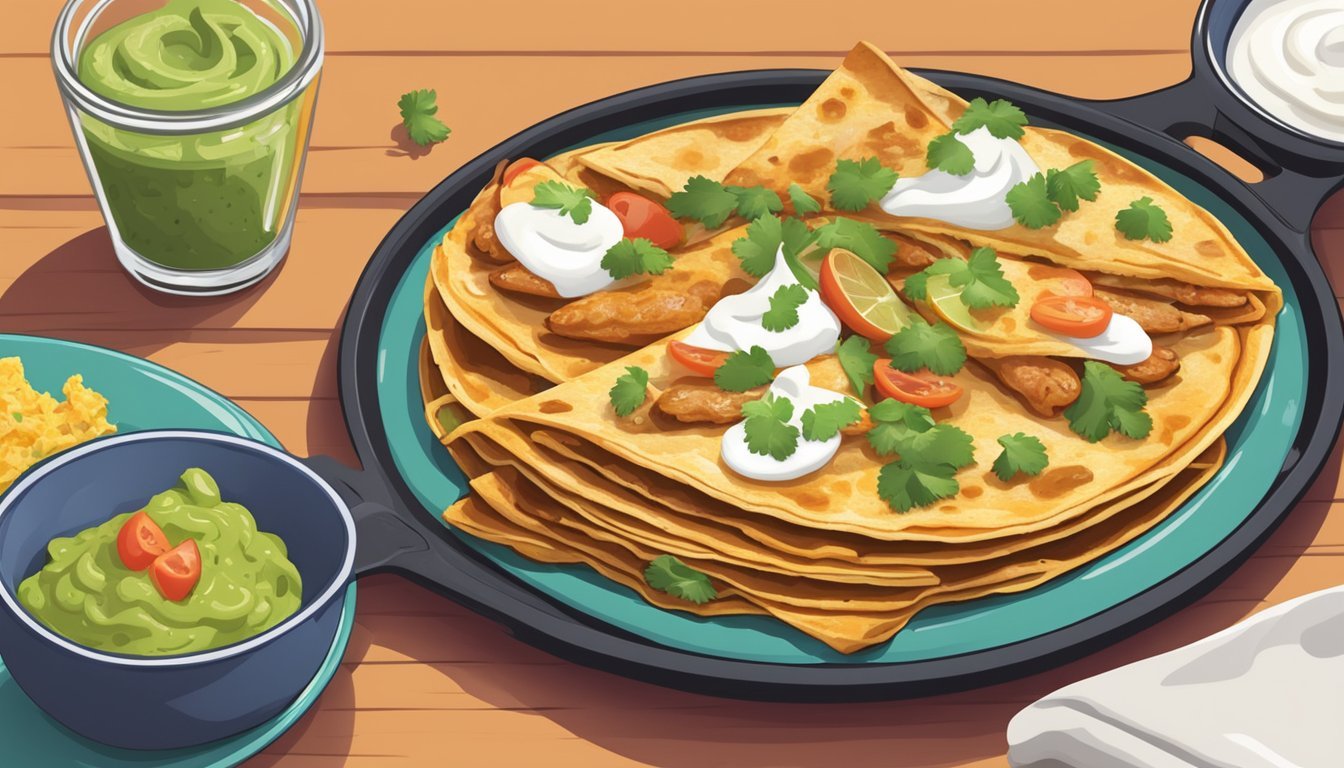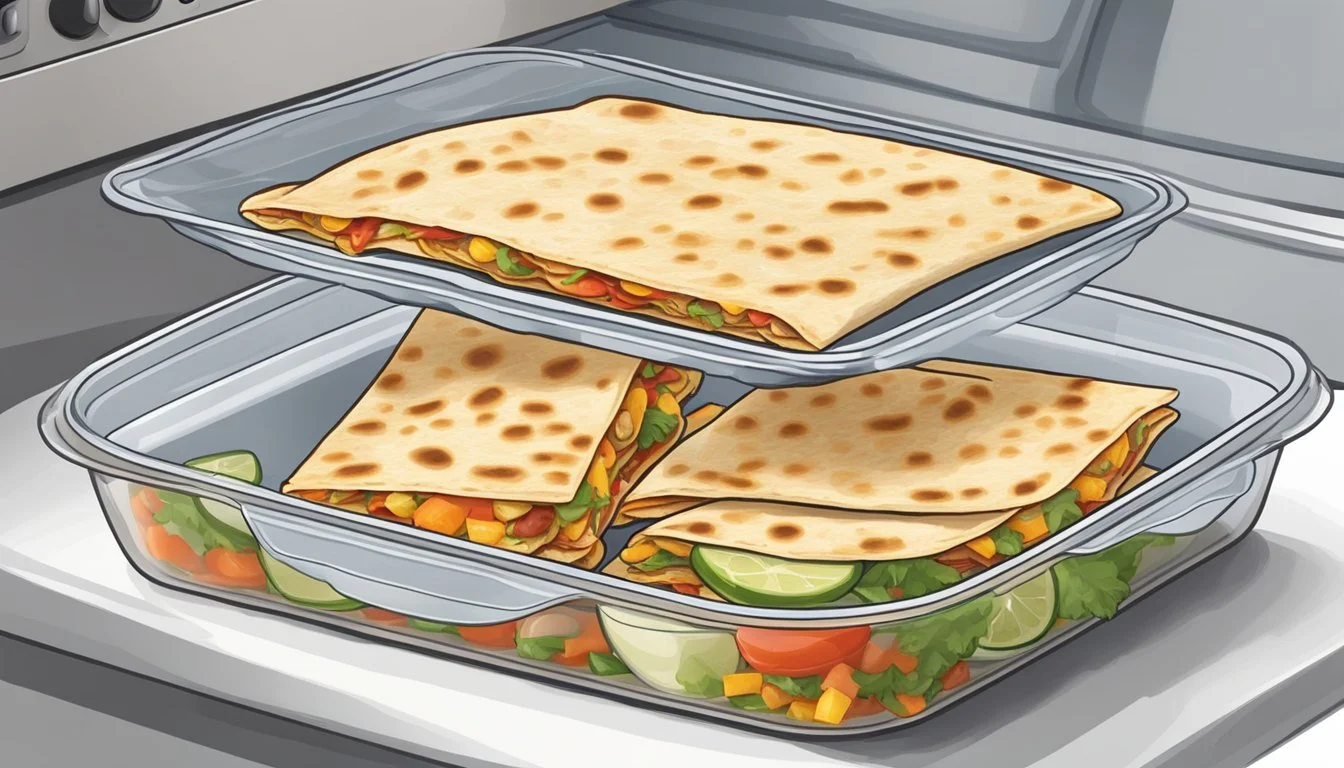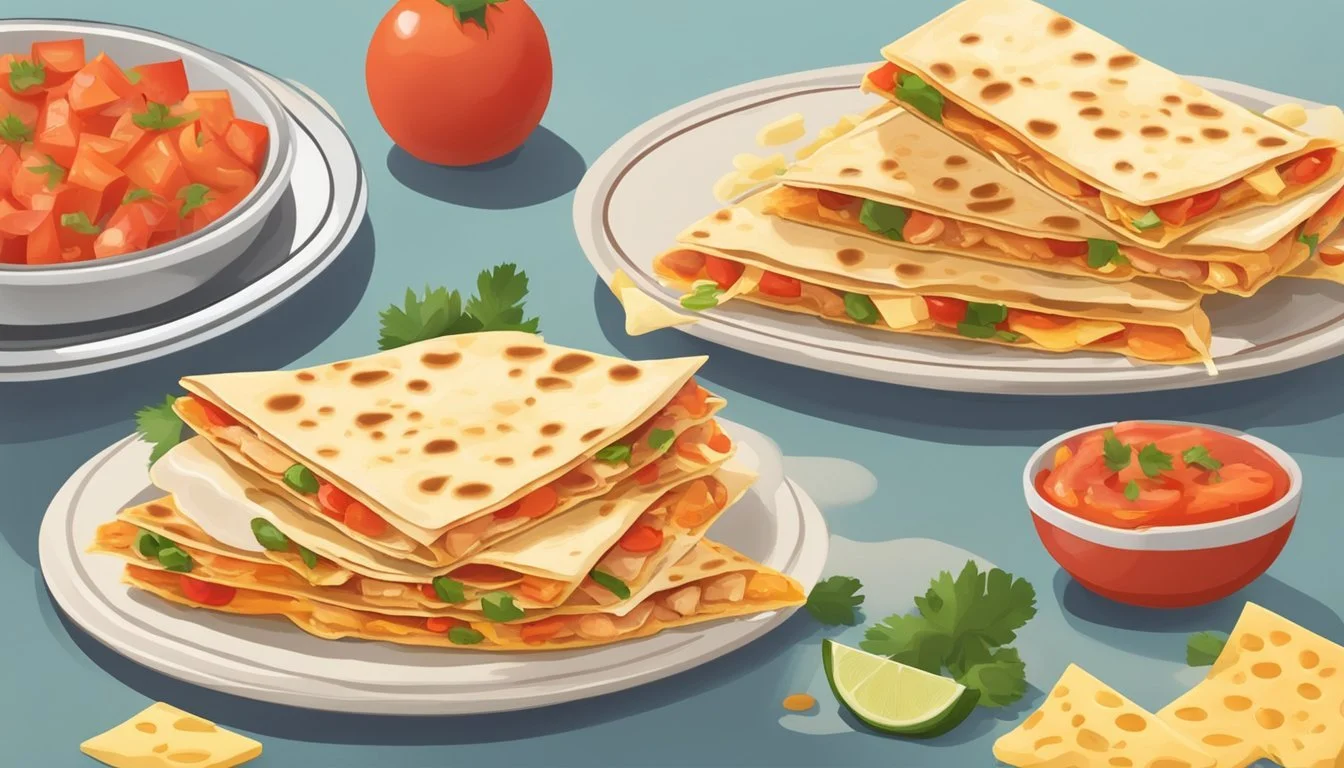How Long Do Chicken Quesadillas Last?
Storage Tips and Best Practices
Chicken quesadillas are a popular dish appreciated for their delicious blend of flavors and ease of preparation. Many people often wonder about the shelf life of these tasty treats once they've been made. Chicken quesadillas typically last for about 3 to 4 days when stored properly in the refrigerator.
To ensure they remain safe to eat, it's crucial to store them in an airtight container soon after cooking. Reheating them correctly can help maintain their texture and taste. If longer storage is necessary, freezing is a viable option.
By knowing the best storage practices, you can always enjoy your chicken quesadillas with confidence, whether they're freshly made or reheated.
Fundamentals of Quesadillas
Quesadillas are a popular Mexican dish that combines tortillas with various fillings, usually cheese and meats like chicken. Understanding the basics of quesadillas includes knowing what defines them, selecting the right ingredients, and recognizing the significance of choosing the right type of tortilla.
Defining the Quesadilla
A quesadilla is traditionally made with either flour or corn tortillas. It typically features cheese as the central filling, with optional additions such as chicken, beef, or vegetables.
The tortilla is folded or sandwiched to encase the fillings, then cooked until the cheese melts and the tortilla becomes crisp.
Popular cheese choices include Monterey Jack, Cheddar, or a blend. Common proteins added are seasoned chicken or beef, which enhance the meal's flavor.
Choosing Your Ingredients
Selecting high-quality ingredients is essential for the best quesadillas. Cheese should be freshly grated to ensure optimal melting and flavor. Monterey Jack and Cheddar are preferred for their melting properties and taste.
Fresh vegetables like bell peppers, onions, and jalapeños add texture and enhance the flavor profile. For the protein component, cooked and seasoned chicken strips or ground beef work well.
Using a bit of oil when cooking can help crisp the tortilla and meld flavors together effectively. Proper seasoning of all ingredients is crucial for a balanced and flavorful quesadilla.
The Importance of Tortilla Selection
The type of tortilla used affects the flavor and texture of the quesadilla. Flour tortillas are more commonly used for their neutral flavor and soft texture, which crisps nicely when cooked.
Corn tortillas offer a distinct taste and are smaller and firmer, adding a unique flavor, but they can be less flexible, making them harder to fold without breaking.
When choosing tortillas, freshness is key. Fresh tortillas yield better flavor and texture, whether they are flour or corn. Large flour tortillas are preferable for making sizable and sturdy quesadillas.
Proper tortilla selection influences the final product, so selecting the right type based on personal preference and recipe requirements is vital for crafting an ideal quesadilla.
Chicken Quesadillas Preparation
Chicken quesadillas can be prepared in several ways, but some core steps ensure a delicious outcome. Whether you're mastering the recipe or customizing your filling, here’s how to make them perfectly.
Mastering the Chicken Quesadilla Recipe
Start by seasoning the chicken breasts with salt, pepper, cumin, paprika, and oregano. Heat olive oil in a skillet over medium-high heat and cook the chicken until it reaches an internal temperature of 165°F, ensuring it is thoroughly cooked but still juicy.
Once done, remove the chicken and let it rest before slicing it into thin strips. This step helps keep the chicken moist. Use a nonstick skillet to lightly brown the tortillas before assembling.
Preparation Techniques for Chicken Quesadillas
Heat the skillet over medium heat and add a small amount of olive oil. Place one tortilla in the pan and sprinkle grated cheese evenly over half of the tortilla. Add the cooked chicken slices, finely chopped onion, garlic, and peppers. Optionally, include corn and beans for added texture and flavor.
Fold the tortilla in half, pressing gently. Cook until the bottom is golden brown and crispy, then flip carefully to cook the other side. Use a wide spatula for easier handling. This method ensures the quesadilla is crispy and the cheese melts uniformly.
Customizing Your Filling
Experiment with different fillings to suit your taste. You can add sour cream or guacamole as toppings. Consider including cilantro for a fresh, herbaceous note, or pickled jalapeños for a spicy kick. Roasted peppers and caramelized onions are great additions for those who appreciate a deeper flavor profile.
For a vegetarian twist, substitute chicken with black beans or grilled vegetables. Customization is key to personalizing the quesadilla, making each bite varied and exciting. Adjust seasoning and spice levels to cater to different palates.
Cooking and Serving
Preparation and presentation are critical when it comes to making chicken quesadillas. To achieve a mouth-watering result, it’s essential to focus on cooking the chicken properly and considering appealing serving methods.
Achieving the Perfect Cook
Cooking the chicken: Start by seasoning the chicken with a blend such as chili powder, cumin, salt, and pepper. Heat a skillet over medium-high heat and add olive oil. Cook the chicken, turning occasionally, until browned and fully cooked, roughly six minutes.
Assembling the quesadilla: Place the cooked chicken in a bowl and allow it to cool. Prepare the filling by adding shredded cheese, and any other desired ingredients such as sautéed vegetables. Spread the filling on one half of a tortilla, fold, and press down gently.
Cooking the quesadilla: Preheat the oven to around 425°F (220°C). Place the assembled quesadillas on a baking sheet lined with parchment paper. Bake until the cheese is fully melted and the tortillas are golden and crisp, about 10-15 minutes. Alternatively, cook on a stovetop griddle or skillet with a bit of butter until each side is golden.
Serving Suggestions
Slicing and presentation: Once cooked, transfer the quesadillas to a cutting board and let them sit for a minute. Cut each quesadilla into wedges using a sharp knife or a pizza cutter for clean slices. Arrange the slices on a platter or individual plates for serving.
Condiments: Offer an array of sauces and dips to complement the flavors. Popular choices include sour cream, salsa, and guacamole. A few wedges of lime add a refreshing zest and can be squeezed over the quesadillas just before eating.
Portioning: Aim to serve about two quesadilla wedges per person as an appetizer or more generous portions as a main dish. Providing a variety of complimentary sides ensures a satisfying and balanced meal.
Accompaniments
Tex-Mex sides: Enhance the meal with classic Tex-Mex accompaniments such as Mexican rice or refried beans. These not only add to the meal's flavor but also its nutritional value.
Fresh vegetables: Serve with a side of pico de gallo or a mixed salad for a fresh, crunchy contrast. Sliced avocado or a simple lettuce and tomato salad also pair well.
Additional options: Considering fajita-style side dishes, like sautéed onions and bell peppers, can create a more vibrant plate. Black beans, corn, or a mixture of sautéed vegetables can be delightful additions to round out the meal.
Preservation and Reheating
Proper storage and reheating methods ensure that your chicken quesadillas remain flavorful and safe to eat. These steps help maintain their texture and taste while maximizing their shelf life.
Storing Chicken Quesadillas
Once cooked, allow chicken quesadillas to cool down to room temperature before storing. Place the quesadillas in an airtight container, using layers of plastic wrap or aluminum foil to separate each piece. This prevents sogginess and preserves freshness.
Store the container in the fridge if you plan to eat them within 3-4 days. For longer storage, place them in a freezer-safe bag and keep them in the freezer for up to 3 months. Label the bag with the date to keep track of how long they have been stored.
Reheating Guidelines
To maintain the texture and avoid a soggy outcome, reheating must be done correctly. For stovetop reheating, use a skillet over medium heat with a small amount of oil. Heat each side of the quesadilla for about 1-2 minutes until it becomes golden brown and crispy.
The oven method involves preheating the oven to 350°F (175°C). Place the quesadillas on a baking sheet and heat for approximately 10 minutes. For those with an air fryer, set it to 350°F and heat the quesadillas for 3-4 minutes.
Maximizing Freshness
To keep chicken quesadillas fresh, avoid leaving them at room temperature for more than two hours. Always use airtight storage methods to protect them from moisture and air. When freezing, ensure tight wrapping or sealing to prevent freezer burn.
Reheating a single portion instead of a whole batch helps maintain quality. If reheating multiple portions, avoid stacking them to ensure even heating. Using proper reheating techniques can preserve the crispy exterior and gooey cheese filling, making them taste as close to freshly made as possible.
Implementing these guidelines ensures that your chicken quesadillas remain enjoyable whether stored in the fridge or freezer. Maintain an organized storage system to avoid food waste and enjoy consistent quality.
Additional Considerations
When making chicken quesadillas, various factors influence their taste, nutritional value, and suitability for different diets. Adaptations and creative variations can enhance the dish.
Nutritional Information
Chicken quesadillas can be a nutritious meal. They provide a balance of protein, carbohydrates, and fats. Using chicken breast adds lean protein while cheese supplies necessary calcium and fat. A typical serving of chicken quesadillas contains around 300-400 calories.
Incorporating vegetables like peppers or black beans can boost vitamins and fiber. For a healthier option, opt for whole wheat tortillas and reduced-fat cheese. Monitor serving size to manage calorie intake, especially if dining out at a restaurant where portions can be larger.
Alternative Diet Adaptations
To accommodate different dietary preferences, consider substitutions. For vegetarian quesadillas, swap chicken with black beans or refried beans. Plant-based cheeses can replace traditional cheese for those avoiding dairy.
For low-carb diets, use low-carb tortillas or leafy greens as wraps. Gluten-free tortillas help those with gluten sensitivities or celiac disease. Including a variety of protein sources such as tofu or shredded pork can also offer diverse flavors without compromising dietary needs.
Creative Variations
Inject creativity into quesadillas with diverse fillings. Traditional cheese choices like Monterey Jack, Cheddar, or Oaxaca can be mixed with other ingredients. For a southwestern twist, add corn, jalapenos, and cilantro.
Opt for different meats such as ground beef or pork. Vegetarian options may include roasted vegetables, spinach, and mushrooms. Experiment with unique sauces like sriracha, BBQ, or pesto to change the flavor profile. Weeknight meals become exciting with these easy and quick-to-make variations.
Incorporating these considerations can not only make chicken quesadillas more nutritious and diverse but also cater to various dietary needs and preferences.







